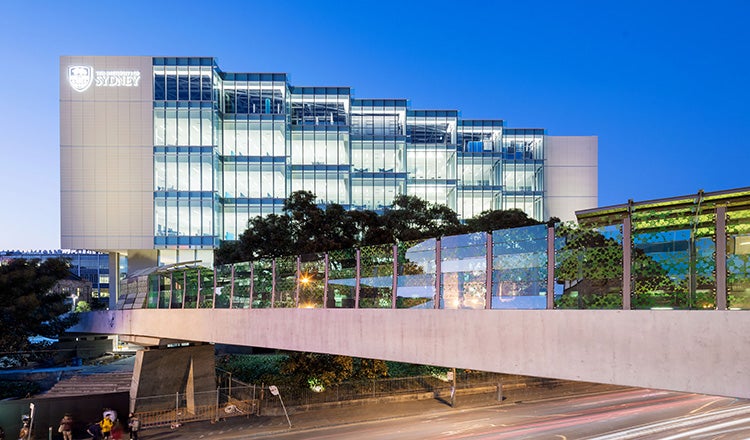![Sydney Biomedical Accelerator [Image credit: Denton Corker Marshall]](/sites/default/files/styles/hero/public/2023-05/SBA-St-Andrews-Oval-d2100-1055.jpg?itok=Ax-7i5J6)
Bench-to-Bedside Translation & Beyond: Designing Next-Gen Biomedical Accelerators
The speed and sophistication of medical research is one of the marvels of the modern day. But outcomes such as the fast-tracking of COVID-19 vaccines from years to months, as just one example, are not accidental. They are the product of an emerging collaborative approach to medicine driven by research institutes, governments, hospitals, higher education establishments, and corporate and funding partners. These drivers are focused on cutting-edge, purpose-built research and development complexes that are prioritizing the transfer of knowledge to a level rarely experienced before.
HDR’s architecture practice — and the group behind the Sydney Biomedical Accelerator — is at the forefront of a design wave supporting ‘translational health science,’ a term given to the convergence of health, education and science to solve complex medical challenges. The design intent is to free scientists from their bunker-style laboratories and facilitate encounters between science and medical professionals through spacious, interconnecting labs and offices. Their well-being is prioritized via access to natural light, fresh air, and spaces for reprieve.
“Back in the early 2000s, labs were individualized,” said Graeme Spencer, HDR national director of education and science in Australia. “Scientists, engineers and technologists would be working across different buildings, often in different campuses or states and often relying on technology development from across the globe.
“But now what we’re seeing is that they are sitting side-by-side sharing ideas, knowledge and specialized equipment. As a result, the throughput of technology and the development of new drugs and therapies is increasing exponentially.
“There's striking evidence around the proximity of researchers as a predictor of collaboration, and so our focus is on optimizing horizontal and vertical movement between laboratory spaces, as well as access to shared meeting and collaboration areas, coffee points and bump spaces.”
![Sydney Biomedical Accelerator [Image credit: Denton Corker Marshall]](/sites/default/files/2023-05/sba-western-avenue-d750-440.jpg)
The Sydney Biomedical Accelerator, due for completion in 2026, will embody this thinking. The precinct is a co-funded partnership project among NSW Health, Sydney Local Health District and the University of Sydney, spanning the university campus and the District’s Royal Prince Alfred Hospital campus. It will bring together 1,200 researchers; seven science, engineering and medical schools; and an array of industry partners in a unique global concentration of biomedical research talent.
This building design pivots on themes to achieve spaces that support the process of transitioning a therapy from research and development to commercialization. “We’re no longer designing for individual departments because themes give us a more accurate indication of the types of activities that could be undertaken,” Spencer said. “For example, you’ll have tuberculosis therapy themes incorporating mass specs, imaging and sequencing groups, drug discovery, structural biology and pre-clinical research. The people carrying out these roles need to be close together and interacting, rather than spread across campus.”
In the Sydney Biomedical Accelerator, open research spaces are considerably larger. Known as ‘super labs,’ they no longer accommodate 30 people but rather up to 120, with the intention of high utilization, connectivity, collaboration and knowledge transfer.
The University of Sydney’s Life, Earth & Environmental Sciences Building — a combination of teaching super laboratories and research spaces, designed by HDR — is another recent example of a building facilitating knowledge transfer.
“There is a huge opportunity for us to design spaces that promote physical awareness of the institutions within a building and power knowledge transfer between expert minds as a result,” Spencer said.
Naturally, as projects come and go, research themes and teams change. "Long life, loose fit" spaces, as Spencer describes them, provide agile environments that can flex to support professionals in doing their best work years into the future.
Changes in the way laboratories are used also support agile environments. There are fewer Bunsen burners and flasks of bubbling chemicals and more work with high-throughput analytical equipment or AI computing power interpreting tides of data.
Diagnostics and precision medicine, artificial intelligence, and bioinformatics (understanding large and complex biological data sets) demand more significant ‘dry lab’ space.
“We're seeing a significant de-risking of open laboratory work, which is supported by a concentration of smaller isolation rooms to meet these demanding environmental or containment needs,” Spencer said. “Labs can be more open and flexible, and it’s really benefiting the energy demands on research buildings.”

Underpinning this integration of health, education and science, and its trailblazing precincts, is a COVID-impacted climate, one that puts health more firmly at the center of our everyday lives, according to Jon Crane, HDR’s global director of translational health.
“The pandemic has not only forced researchers and scientists to translate new diagnostic tools and treatments from bench to a patient’s bedside at unparalleled speeds, but it has put global health policy under a microscope and facilitated a monumental shift towards preventative health and well-being at both a personal and community level,” Crane said. “As architects and planners, it is our job to enable this acceleration by integrating spaces for collaboration, flexibility and adaptability, so that we, too, can play a meaningful role in accelerating research-to-patient benefit.”
In addition, advances in technology, such as automated genome sequencers and the extraordinary amounts of data they produce, are leading to unprecedented levels of discovery and disruption in the health space.
“The human genome project, which gave us the full spectrum of human genetic material, began in 1990 and took 10 years and $10 billion to complete,” Spencer said. “A human genome can be sequenced today in fewer than 24 hours for around $1,000. We are experiencing an incredible evolution of technology that is supporting researchers and health outcomes. Technology is creating a new generation of health researchers who are both multi-skilled and multi-disciplined and require state-of-the-art spaces to create the breakthroughs our patient populations are relying on.”
Moving forward, developing facilities to support the next generation of creativity and knowledge transfer is key to accelerating the benefit of research into health outcomes.
Image credit: Denton Corker Marshall




